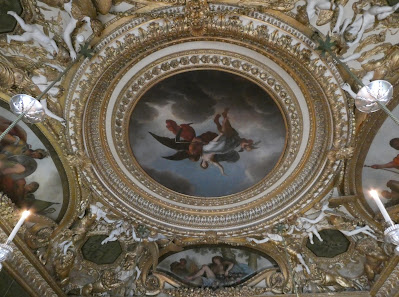One of the reasons that we stayed for two nights in Melun--besides stretching out our cruise time so that we don't arrive in Auxerre too early--was to be able to visit the Chateau de Vaux-le-Vicomte just a few kilometers outside of Melun. The chateau was the creation of three artisans of the mid-1600's engaged by Nicolas Fouquet, the superintendent of finances to Louis XIV.
The original property owned by Fouquet had a small chateau; however, Monsieur Fouquet had grand ambitions and extravagant taste. When all was said and done, three villages had been purchased and destroyed to obtain enough land for the enlarged chateau and gardens. Built between 1658 and 1661, it is one of the largest castles in France and became an inspiration for the Palace of Versailles. Unfortunately for Fouquet, he didn't have much time to enjoy what had been created for him. He had hoped to impress Louis XIV with the grandeur--in fact, part of the chateau was constructed with rooms specifically for the king--but a too-lavish celebration to honor the King on August 17, 1661, and court intrigues led by Jean-Baptiste Colbert, convinced Louis that the home was constructed with misappropriated public funds. Fouquet was replaced in his position by Colbert, who later had Fouquet arrested for embezzlement as well as treason.
Fouquet's subsequent trial dragged on for nearly three years. Found guilty of embezzlement, the presiding judges voted for banishment rather than death, but Louis XIV used his pardoning power to change the sentence to life imprisonment. This was the only time in French history a Monarch used his pardoning power to worsen a sentence. Fouquet died in Pignerol prison in the Alps in 1680.
 |
| Standing at the bottom of the back steps, with the sweep of the center lawn/formal gardens behind us. The woodsy areas to each side are also part of the estate. |
 |
| View from the 2nd floor balcony in one wing of the chateau, overlooking the front lawn and the stables. |
 |
| If it's Louis XIV era decorating--and especially if designed to impress the king himself--you know that paintings and gold are going to be everywhere. |
 |
| The dining room. |
 |
| The king's bedroom. |
 |
| The rooms are decorated with authentic 17th C furnishings, as though Nicolas Fouquet and his family were living there. |
 |
| Decorated panels on the shutters of an interior window. |
 |
| There are stretches with absolutely stunning houses. |
 |
| The Gate of Burgundy, the east gate into the town. The old timbered building to the right of the gate housed a restaurant with delicious crepes. |
 |
| View of Notre-Dame-de-la-Nativite church (12th-13th C) as seen through a portal of one of the old mills on the Loing River. |
 |
| Looking down the main street of Moret-sur-Loing from the Burgundy Gate toward the Samois Gate, the western entry into the old town. |
 |
| The Graciot Mill on the Loing River, formerly used in the tanning process, now an arts center. |
 |
| The church's Renaissance organ, among the oldest in France. |
 |
| The skyline of the town from the Pre de Pins park on the banks of the Loing. Sisley painted several canvases from vantage points in the park (as well as elsewhere in the town). |




No comments:
Post a Comment